Dissertation: Brand Extensions for Low Fit Brands (Adidas, Toyota)
VerifiedAdded on 2022/11/07
|86
|18903
|320
Thesis and Dissertation
AI Summary
This dissertation investigates the factors that contribute to the success of brand extensions, particularly in low-fit scenarios, using Adidas and Toyota as case studies. The research explores the motivations behind brand extensions, the challenges faced, and the role of David Aaker's brand equity model. The study examines how factors such as curiosity, innovativeness, sustainability, and marketing influence the success of extensions like Adidas's and Toyota's ventures into product categories such as bathing gels, energy drinks, and furniture. The research employs a quantitative approach, analyzing data to determine the impact of various factors on consumer perception, purchase intention, and brand loyalty. The findings reject the null hypotheses for both brands, suggesting that specific factors significantly influence successful brand extensions, even when the fit between the parent brand and the extension is low. The dissertation also provides theoretical and managerial implications, along with limitations and suggestions for future research, contributing to the understanding of brand extension strategies in a competitive market.
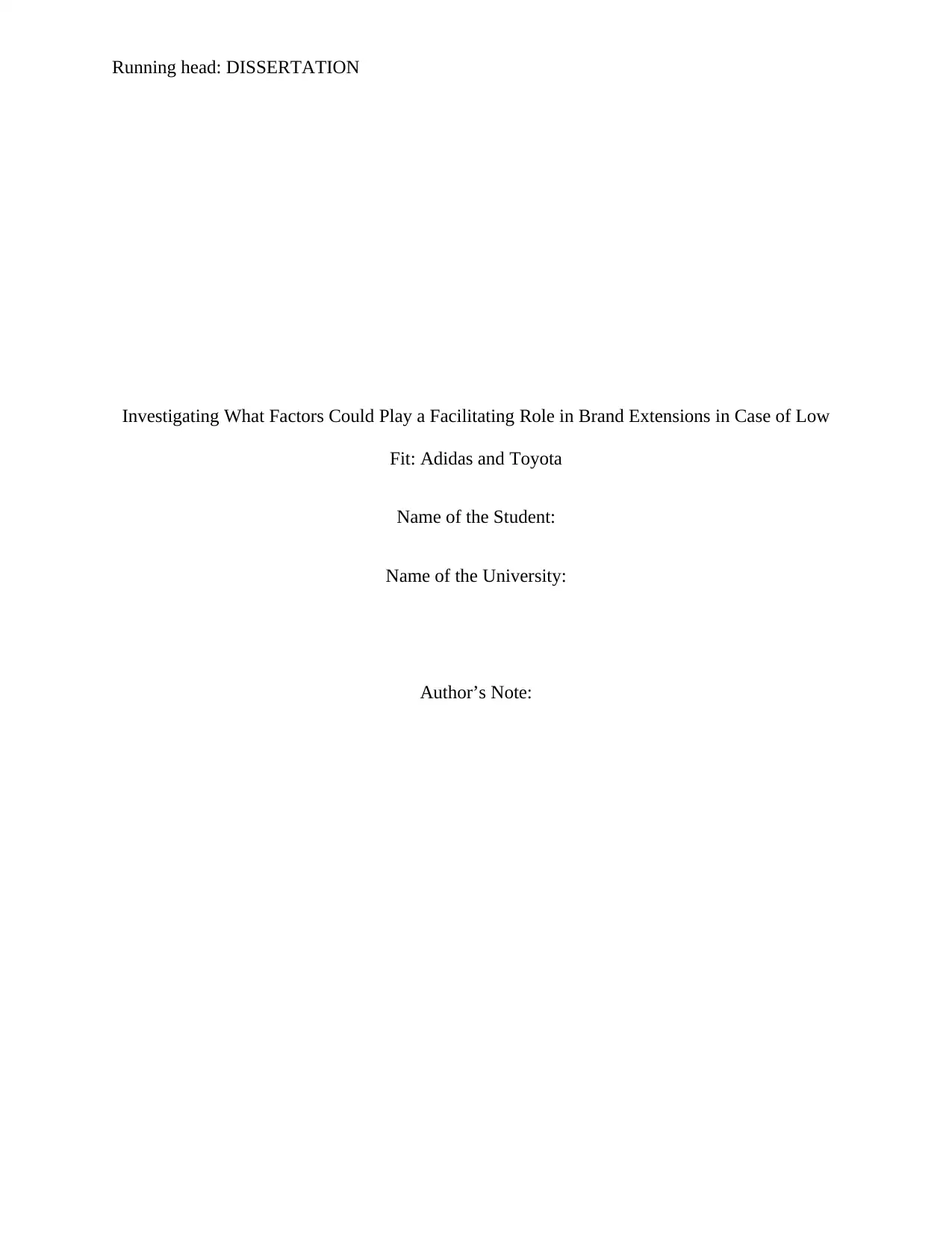
Running head: DISSERTATION
Investigating What Factors Could Play a Facilitating Role in Brand Extensions in Case of Low
Fit: Adidas and Toyota
Name of the Student:
Name of the University:
Author’s Note:
Investigating What Factors Could Play a Facilitating Role in Brand Extensions in Case of Low
Fit: Adidas and Toyota
Name of the Student:
Name of the University:
Author’s Note:
Paraphrase This Document
Need a fresh take? Get an instant paraphrase of this document with our AI Paraphraser
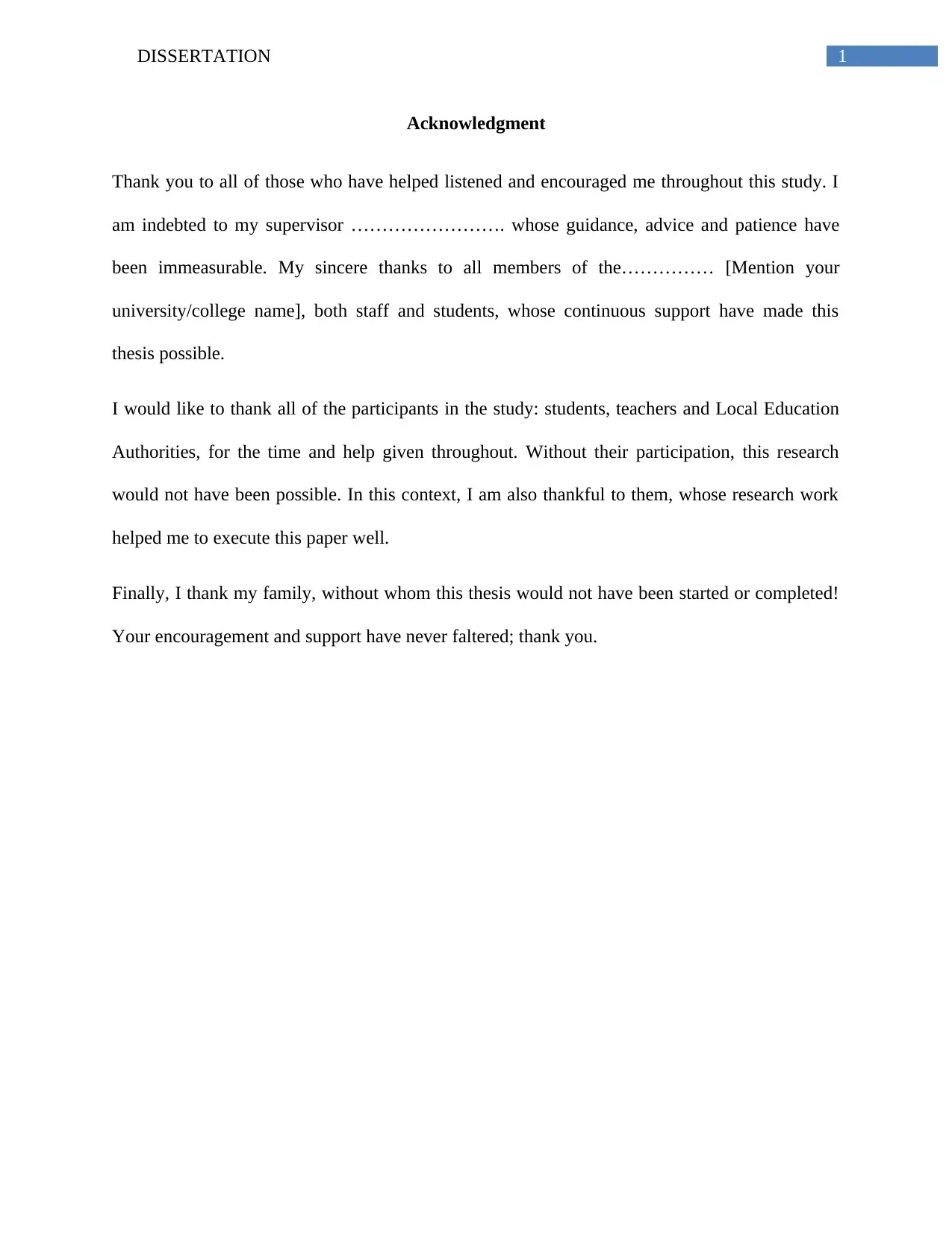
1DISSERTATION
Acknowledgment
Thank you to all of those who have helped listened and encouraged me throughout this study. I
am indebted to my supervisor ……………………. whose guidance, advice and patience have
been immeasurable. My sincere thanks to all members of the…………… [Mention your
university/college name], both staff and students, whose continuous support have made this
thesis possible.
I would like to thank all of the participants in the study: students, teachers and Local Education
Authorities, for the time and help given throughout. Without their participation, this research
would not have been possible. In this context, I am also thankful to them, whose research work
helped me to execute this paper well.
Finally, I thank my family, without whom this thesis would not have been started or completed!
Your encouragement and support have never faltered; thank you.
Acknowledgment
Thank you to all of those who have helped listened and encouraged me throughout this study. I
am indebted to my supervisor ……………………. whose guidance, advice and patience have
been immeasurable. My sincere thanks to all members of the…………… [Mention your
university/college name], both staff and students, whose continuous support have made this
thesis possible.
I would like to thank all of the participants in the study: students, teachers and Local Education
Authorities, for the time and help given throughout. Without their participation, this research
would not have been possible. In this context, I am also thankful to them, whose research work
helped me to execute this paper well.
Finally, I thank my family, without whom this thesis would not have been started or completed!
Your encouragement and support have never faltered; thank you.
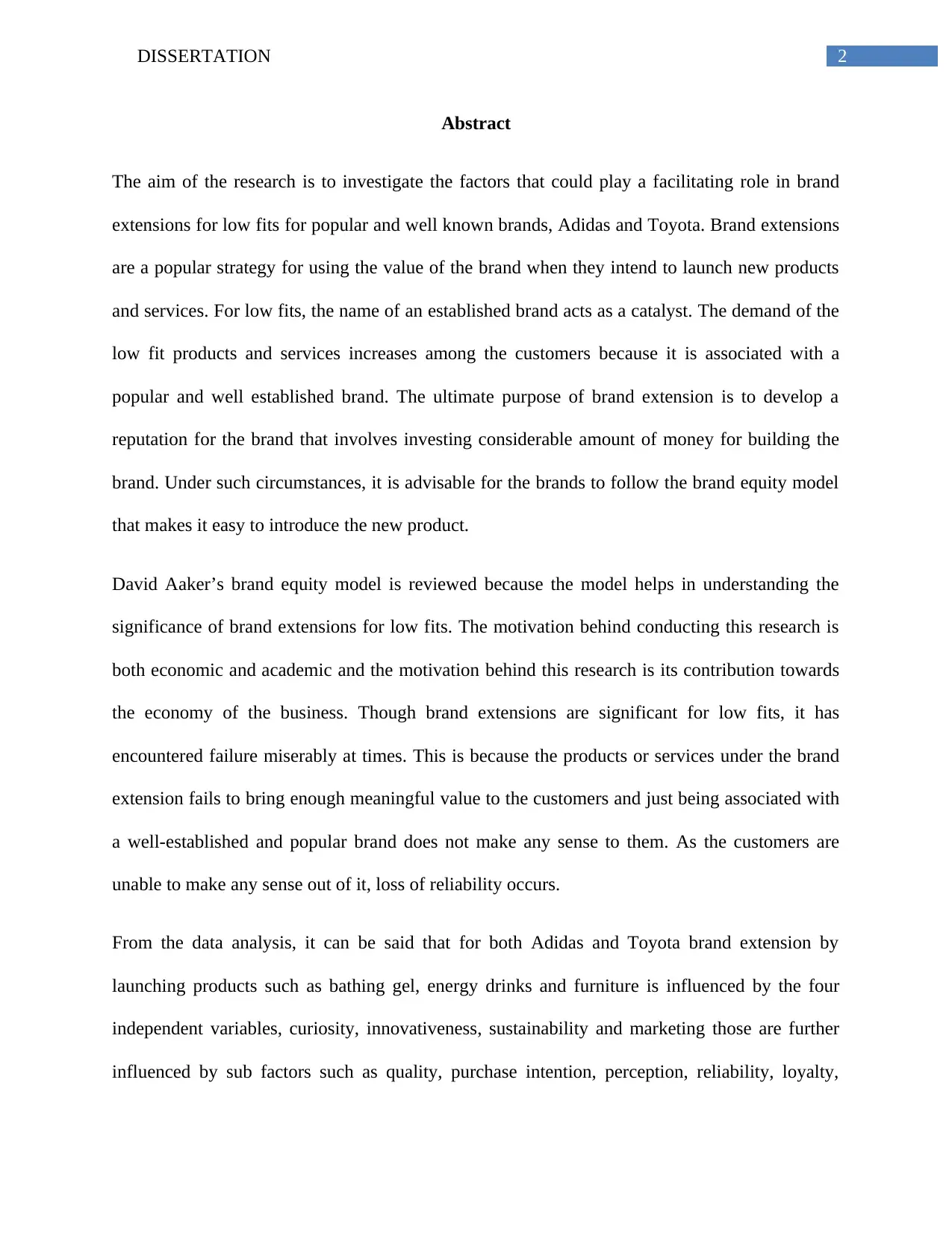
2DISSERTATION
Abstract
The aim of the research is to investigate the factors that could play a facilitating role in brand
extensions for low fits for popular and well known brands, Adidas and Toyota. Brand extensions
are a popular strategy for using the value of the brand when they intend to launch new products
and services. For low fits, the name of an established brand acts as a catalyst. The demand of the
low fit products and services increases among the customers because it is associated with a
popular and well established brand. The ultimate purpose of brand extension is to develop a
reputation for the brand that involves investing considerable amount of money for building the
brand. Under such circumstances, it is advisable for the brands to follow the brand equity model
that makes it easy to introduce the new product.
David Aaker’s brand equity model is reviewed because the model helps in understanding the
significance of brand extensions for low fits. The motivation behind conducting this research is
both economic and academic and the motivation behind this research is its contribution towards
the economy of the business. Though brand extensions are significant for low fits, it has
encountered failure miserably at times. This is because the products or services under the brand
extension fails to bring enough meaningful value to the customers and just being associated with
a well-established and popular brand does not make any sense to them. As the customers are
unable to make any sense out of it, loss of reliability occurs.
From the data analysis, it can be said that for both Adidas and Toyota brand extension by
launching products such as bathing gel, energy drinks and furniture is influenced by the four
independent variables, curiosity, innovativeness, sustainability and marketing those are further
influenced by sub factors such as quality, purchase intention, perception, reliability, loyalty,
Abstract
The aim of the research is to investigate the factors that could play a facilitating role in brand
extensions for low fits for popular and well known brands, Adidas and Toyota. Brand extensions
are a popular strategy for using the value of the brand when they intend to launch new products
and services. For low fits, the name of an established brand acts as a catalyst. The demand of the
low fit products and services increases among the customers because it is associated with a
popular and well established brand. The ultimate purpose of brand extension is to develop a
reputation for the brand that involves investing considerable amount of money for building the
brand. Under such circumstances, it is advisable for the brands to follow the brand equity model
that makes it easy to introduce the new product.
David Aaker’s brand equity model is reviewed because the model helps in understanding the
significance of brand extensions for low fits. The motivation behind conducting this research is
both economic and academic and the motivation behind this research is its contribution towards
the economy of the business. Though brand extensions are significant for low fits, it has
encountered failure miserably at times. This is because the products or services under the brand
extension fails to bring enough meaningful value to the customers and just being associated with
a well-established and popular brand does not make any sense to them. As the customers are
unable to make any sense out of it, loss of reliability occurs.
From the data analysis, it can be said that for both Adidas and Toyota brand extension by
launching products such as bathing gel, energy drinks and furniture is influenced by the four
independent variables, curiosity, innovativeness, sustainability and marketing those are further
influenced by sub factors such as quality, purchase intention, perception, reliability, loyalty,
⊘ This is a preview!⊘
Do you want full access?
Subscribe today to unlock all pages.

Trusted by 1+ million students worldwide
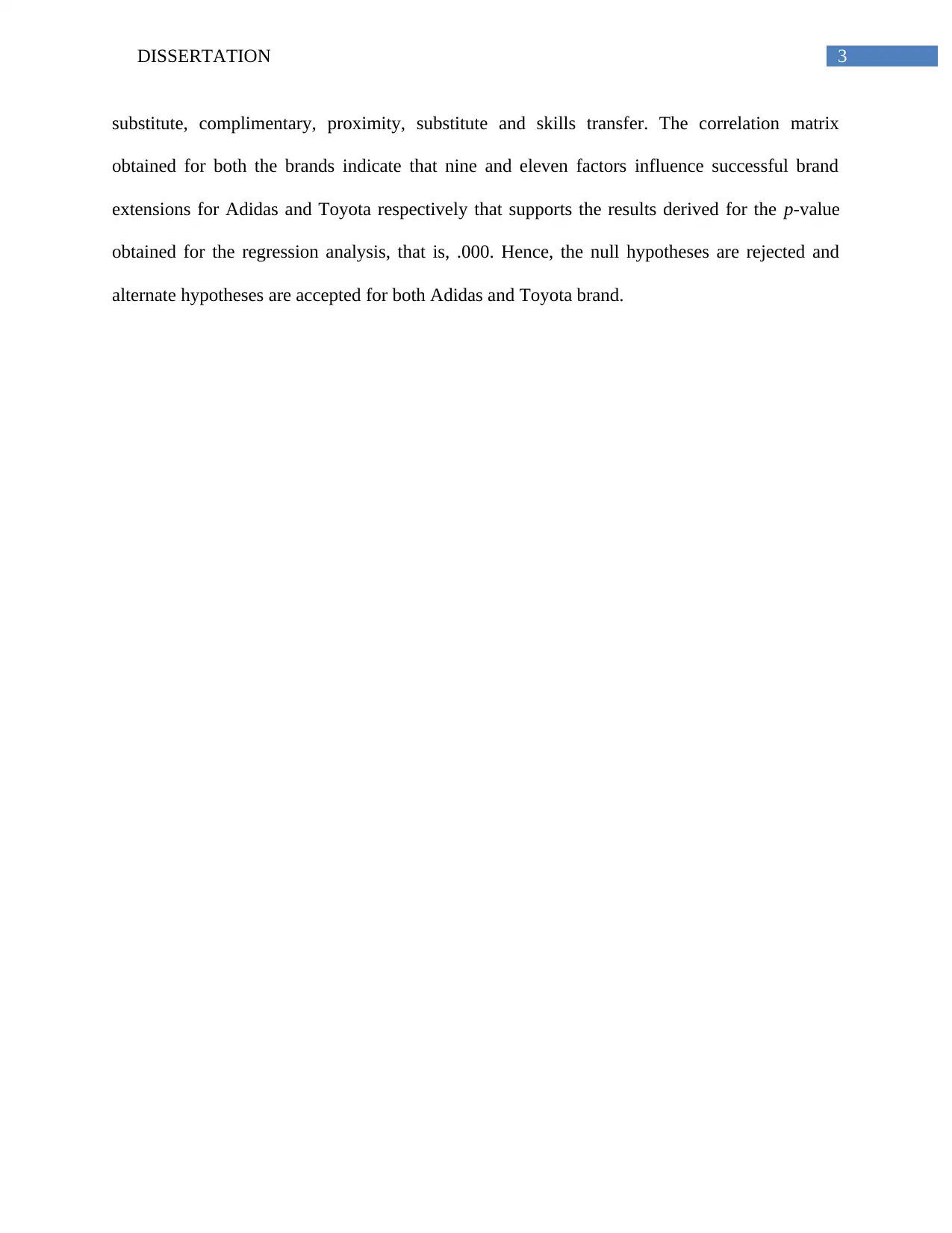
3DISSERTATION
substitute, complimentary, proximity, substitute and skills transfer. The correlation matrix
obtained for both the brands indicate that nine and eleven factors influence successful brand
extensions for Adidas and Toyota respectively that supports the results derived for the p-value
obtained for the regression analysis, that is, .000. Hence, the null hypotheses are rejected and
alternate hypotheses are accepted for both Adidas and Toyota brand.
substitute, complimentary, proximity, substitute and skills transfer. The correlation matrix
obtained for both the brands indicate that nine and eleven factors influence successful brand
extensions for Adidas and Toyota respectively that supports the results derived for the p-value
obtained for the regression analysis, that is, .000. Hence, the null hypotheses are rejected and
alternate hypotheses are accepted for both Adidas and Toyota brand.
Paraphrase This Document
Need a fresh take? Get an instant paraphrase of this document with our AI Paraphraser
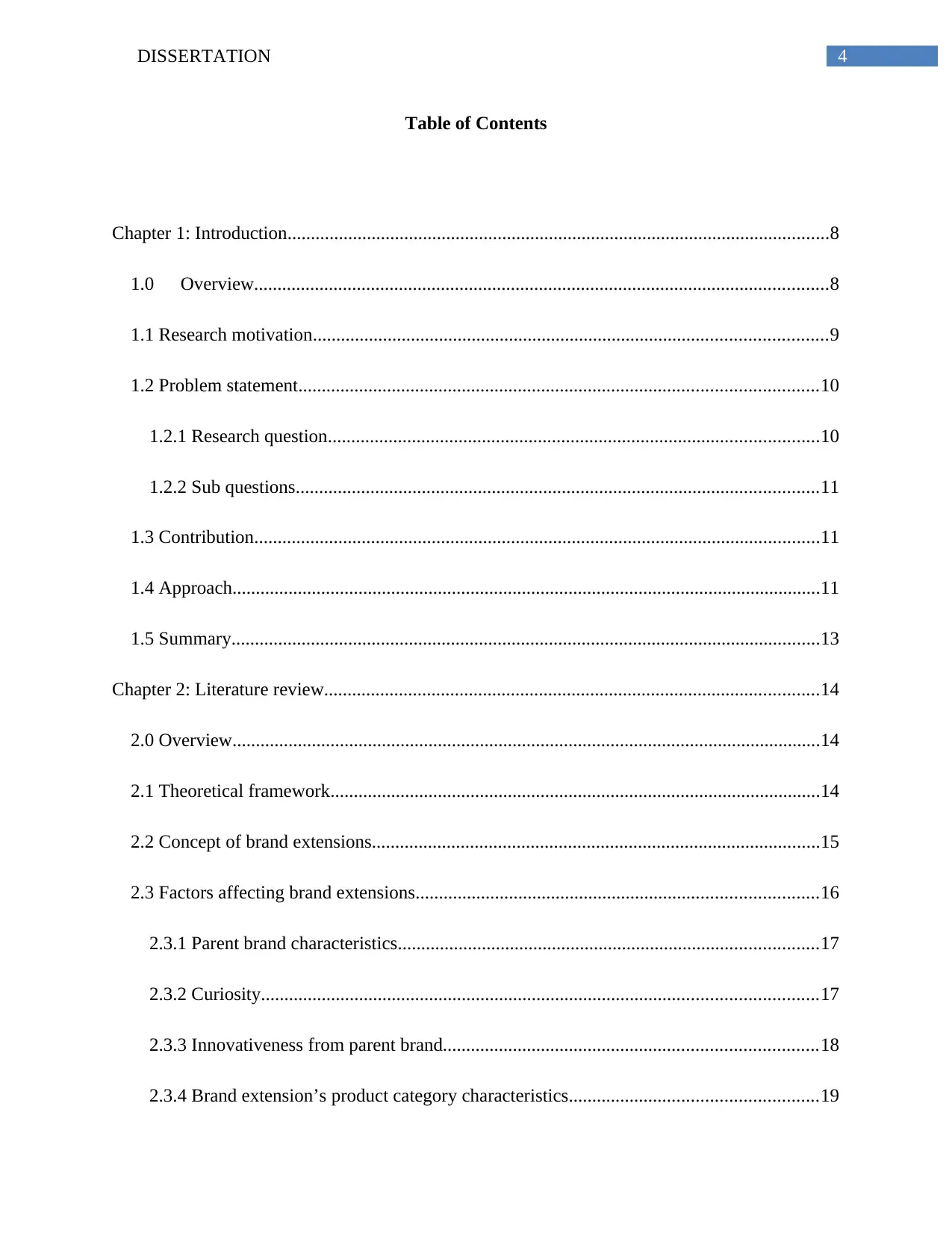
4DISSERTATION
Table of Contents
Chapter 1: Introduction....................................................................................................................8
1.0 Overview...........................................................................................................................8
1.1 Research motivation..............................................................................................................9
1.2 Problem statement...............................................................................................................10
1.2.1 Research question.........................................................................................................10
1.2.2 Sub questions................................................................................................................11
1.3 Contribution.........................................................................................................................11
1.4 Approach..............................................................................................................................11
1.5 Summary..............................................................................................................................13
Chapter 2: Literature review..........................................................................................................14
2.0 Overview..............................................................................................................................14
2.1 Theoretical framework.........................................................................................................14
2.2 Concept of brand extensions................................................................................................15
2.3 Factors affecting brand extensions......................................................................................16
2.3.1 Parent brand characteristics..........................................................................................17
2.3.2 Curiosity.......................................................................................................................17
2.3.3 Innovativeness from parent brand................................................................................18
2.3.4 Brand extension’s product category characteristics.....................................................19
Table of Contents
Chapter 1: Introduction....................................................................................................................8
1.0 Overview...........................................................................................................................8
1.1 Research motivation..............................................................................................................9
1.2 Problem statement...............................................................................................................10
1.2.1 Research question.........................................................................................................10
1.2.2 Sub questions................................................................................................................11
1.3 Contribution.........................................................................................................................11
1.4 Approach..............................................................................................................................11
1.5 Summary..............................................................................................................................13
Chapter 2: Literature review..........................................................................................................14
2.0 Overview..............................................................................................................................14
2.1 Theoretical framework.........................................................................................................14
2.2 Concept of brand extensions................................................................................................15
2.3 Factors affecting brand extensions......................................................................................16
2.3.1 Parent brand characteristics..........................................................................................17
2.3.2 Curiosity.......................................................................................................................17
2.3.3 Innovativeness from parent brand................................................................................18
2.3.4 Brand extension’s product category characteristics.....................................................19
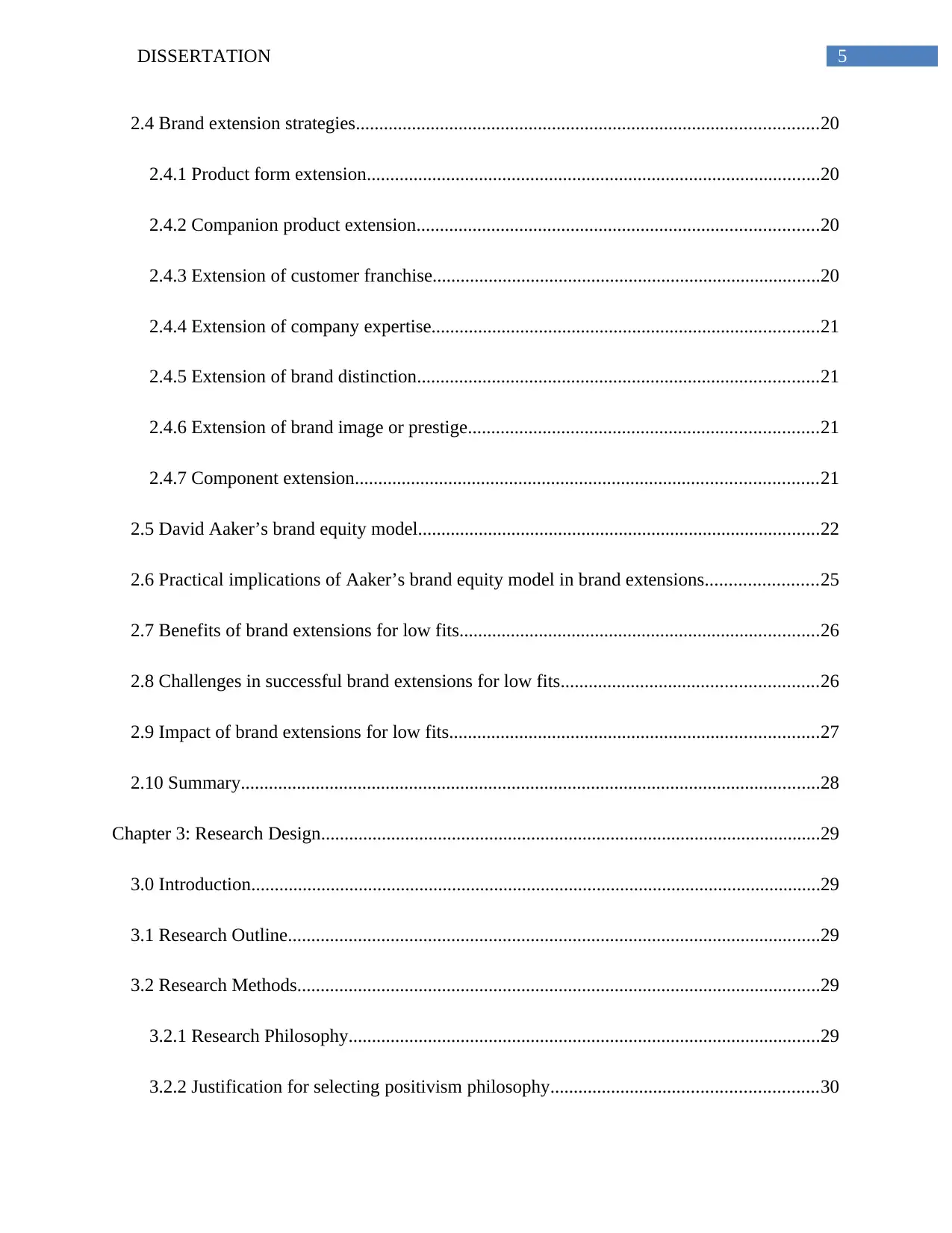
5DISSERTATION
2.4 Brand extension strategies...................................................................................................20
2.4.1 Product form extension.................................................................................................20
2.4.2 Companion product extension......................................................................................20
2.4.3 Extension of customer franchise...................................................................................20
2.4.4 Extension of company expertise...................................................................................21
2.4.5 Extension of brand distinction......................................................................................21
2.4.6 Extension of brand image or prestige...........................................................................21
2.4.7 Component extension...................................................................................................21
2.5 David Aaker’s brand equity model......................................................................................22
2.6 Practical implications of Aaker’s brand equity model in brand extensions........................25
2.7 Benefits of brand extensions for low fits.............................................................................26
2.8 Challenges in successful brand extensions for low fits.......................................................26
2.9 Impact of brand extensions for low fits...............................................................................27
2.10 Summary............................................................................................................................28
Chapter 3: Research Design...........................................................................................................29
3.0 Introduction..........................................................................................................................29
3.1 Research Outline..................................................................................................................29
3.2 Research Methods................................................................................................................29
3.2.1 Research Philosophy.....................................................................................................29
3.2.2 Justification for selecting positivism philosophy.........................................................30
2.4 Brand extension strategies...................................................................................................20
2.4.1 Product form extension.................................................................................................20
2.4.2 Companion product extension......................................................................................20
2.4.3 Extension of customer franchise...................................................................................20
2.4.4 Extension of company expertise...................................................................................21
2.4.5 Extension of brand distinction......................................................................................21
2.4.6 Extension of brand image or prestige...........................................................................21
2.4.7 Component extension...................................................................................................21
2.5 David Aaker’s brand equity model......................................................................................22
2.6 Practical implications of Aaker’s brand equity model in brand extensions........................25
2.7 Benefits of brand extensions for low fits.............................................................................26
2.8 Challenges in successful brand extensions for low fits.......................................................26
2.9 Impact of brand extensions for low fits...............................................................................27
2.10 Summary............................................................................................................................28
Chapter 3: Research Design...........................................................................................................29
3.0 Introduction..........................................................................................................................29
3.1 Research Outline..................................................................................................................29
3.2 Research Methods................................................................................................................29
3.2.1 Research Philosophy.....................................................................................................29
3.2.2 Justification for selecting positivism philosophy.........................................................30
⊘ This is a preview!⊘
Do you want full access?
Subscribe today to unlock all pages.

Trusted by 1+ million students worldwide
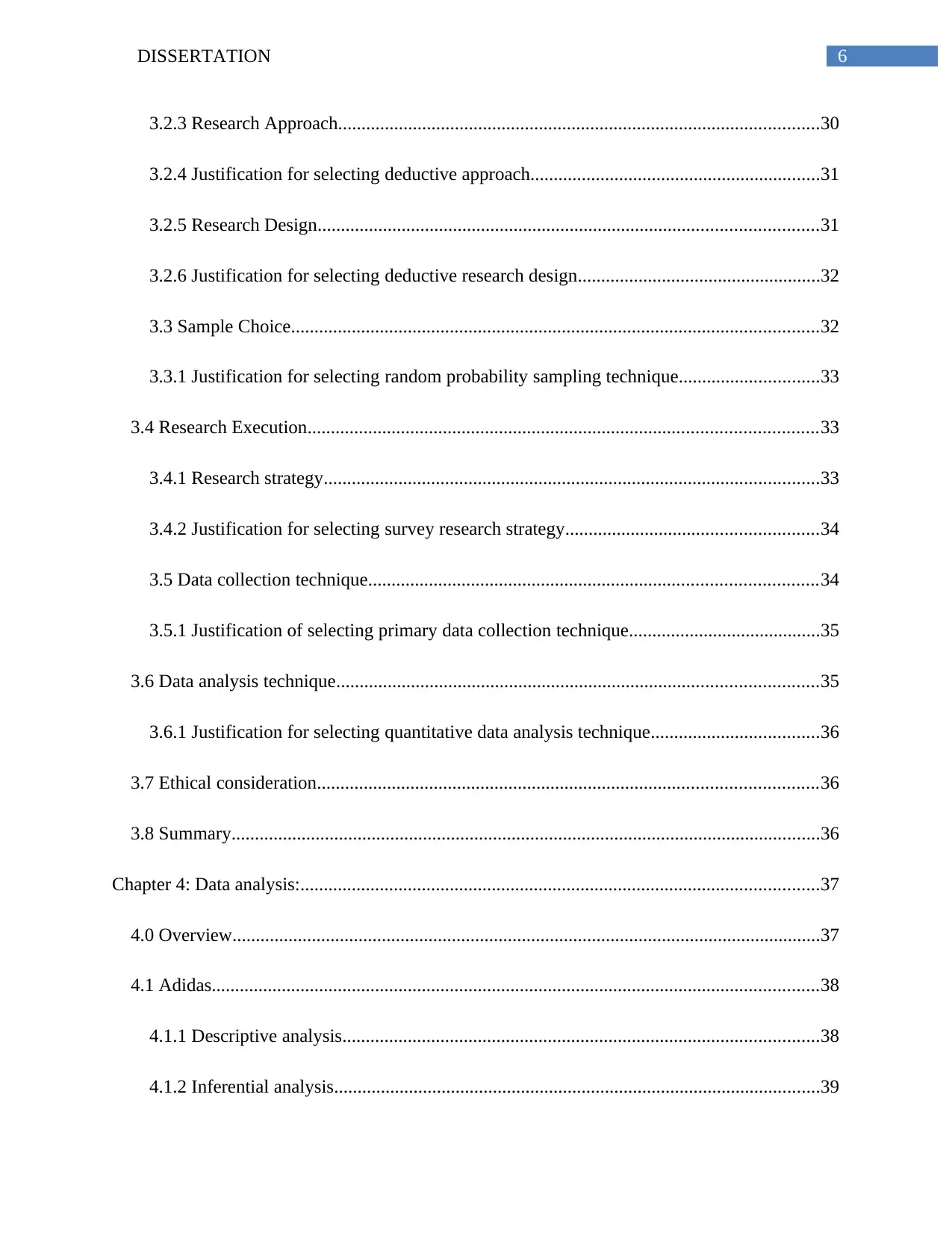
6DISSERTATION
3.2.3 Research Approach.......................................................................................................30
3.2.4 Justification for selecting deductive approach..............................................................31
3.2.5 Research Design...........................................................................................................31
3.2.6 Justification for selecting deductive research design....................................................32
3.3 Sample Choice.................................................................................................................32
3.3.1 Justification for selecting random probability sampling technique..............................33
3.4 Research Execution.............................................................................................................33
3.4.1 Research strategy..........................................................................................................33
3.4.2 Justification for selecting survey research strategy......................................................34
3.5 Data collection technique................................................................................................34
3.5.1 Justification of selecting primary data collection technique.........................................35
3.6 Data analysis technique.......................................................................................................35
3.6.1 Justification for selecting quantitative data analysis technique....................................36
3.7 Ethical consideration...........................................................................................................36
3.8 Summary..............................................................................................................................36
Chapter 4: Data analysis:...............................................................................................................37
4.0 Overview..............................................................................................................................37
4.1 Adidas..................................................................................................................................38
4.1.1 Descriptive analysis......................................................................................................38
4.1.2 Inferential analysis........................................................................................................39
3.2.3 Research Approach.......................................................................................................30
3.2.4 Justification for selecting deductive approach..............................................................31
3.2.5 Research Design...........................................................................................................31
3.2.6 Justification for selecting deductive research design....................................................32
3.3 Sample Choice.................................................................................................................32
3.3.1 Justification for selecting random probability sampling technique..............................33
3.4 Research Execution.............................................................................................................33
3.4.1 Research strategy..........................................................................................................33
3.4.2 Justification for selecting survey research strategy......................................................34
3.5 Data collection technique................................................................................................34
3.5.1 Justification of selecting primary data collection technique.........................................35
3.6 Data analysis technique.......................................................................................................35
3.6.1 Justification for selecting quantitative data analysis technique....................................36
3.7 Ethical consideration...........................................................................................................36
3.8 Summary..............................................................................................................................36
Chapter 4: Data analysis:...............................................................................................................37
4.0 Overview..............................................................................................................................37
4.1 Adidas..................................................................................................................................38
4.1.1 Descriptive analysis......................................................................................................38
4.1.2 Inferential analysis........................................................................................................39
Paraphrase This Document
Need a fresh take? Get an instant paraphrase of this document with our AI Paraphraser
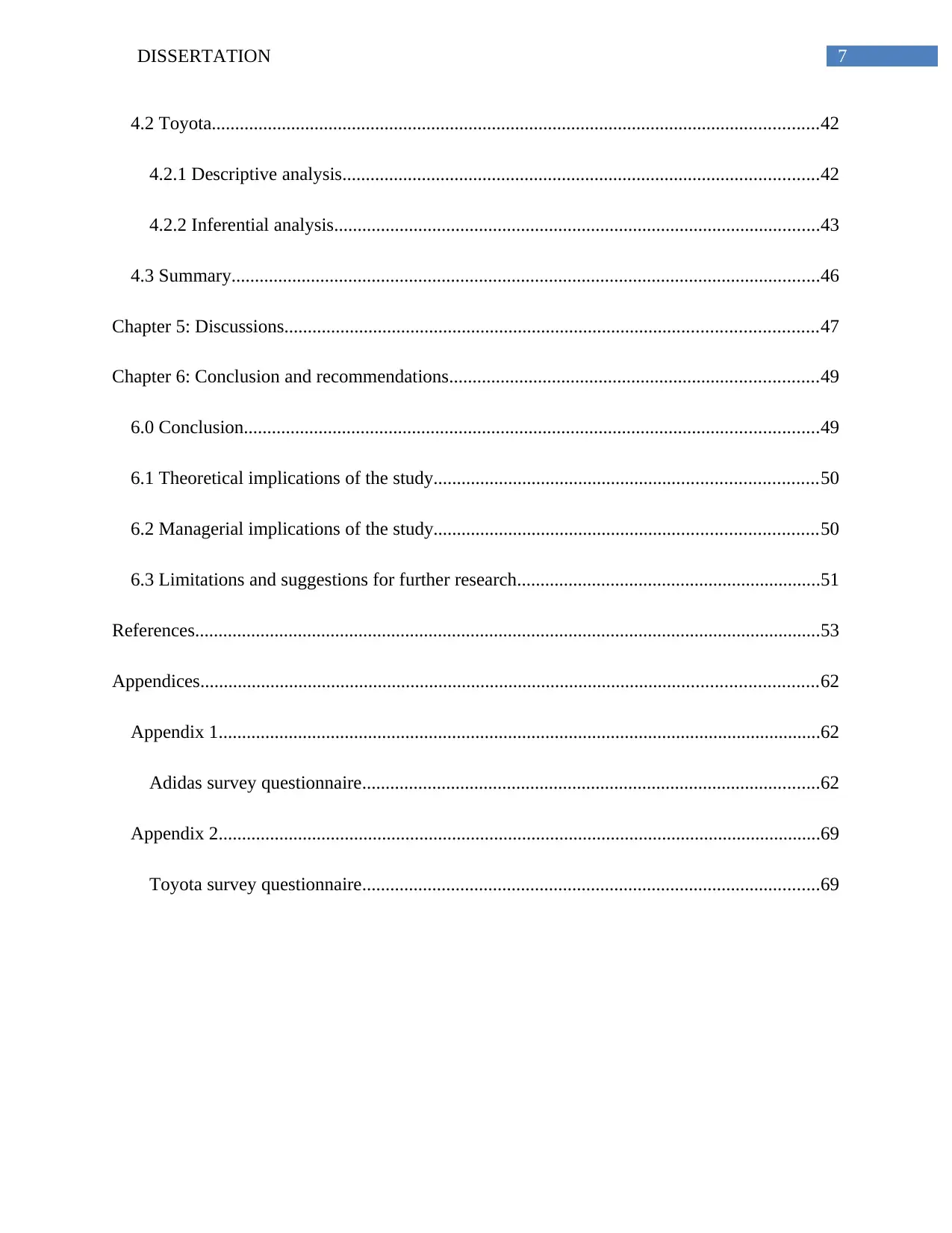
7DISSERTATION
4.2 Toyota..................................................................................................................................42
4.2.1 Descriptive analysis......................................................................................................42
4.2.2 Inferential analysis........................................................................................................43
4.3 Summary..............................................................................................................................46
Chapter 5: Discussions..................................................................................................................47
Chapter 6: Conclusion and recommendations...............................................................................49
6.0 Conclusion...........................................................................................................................49
6.1 Theoretical implications of the study..................................................................................50
6.2 Managerial implications of the study..................................................................................50
6.3 Limitations and suggestions for further research.................................................................51
References......................................................................................................................................53
Appendices....................................................................................................................................62
Appendix 1.................................................................................................................................62
Adidas survey questionnaire..................................................................................................62
Appendix 2.................................................................................................................................69
Toyota survey questionnaire..................................................................................................69
4.2 Toyota..................................................................................................................................42
4.2.1 Descriptive analysis......................................................................................................42
4.2.2 Inferential analysis........................................................................................................43
4.3 Summary..............................................................................................................................46
Chapter 5: Discussions..................................................................................................................47
Chapter 6: Conclusion and recommendations...............................................................................49
6.0 Conclusion...........................................................................................................................49
6.1 Theoretical implications of the study..................................................................................50
6.2 Managerial implications of the study..................................................................................50
6.3 Limitations and suggestions for further research.................................................................51
References......................................................................................................................................53
Appendices....................................................................................................................................62
Appendix 1.................................................................................................................................62
Adidas survey questionnaire..................................................................................................62
Appendix 2.................................................................................................................................69
Toyota survey questionnaire..................................................................................................69
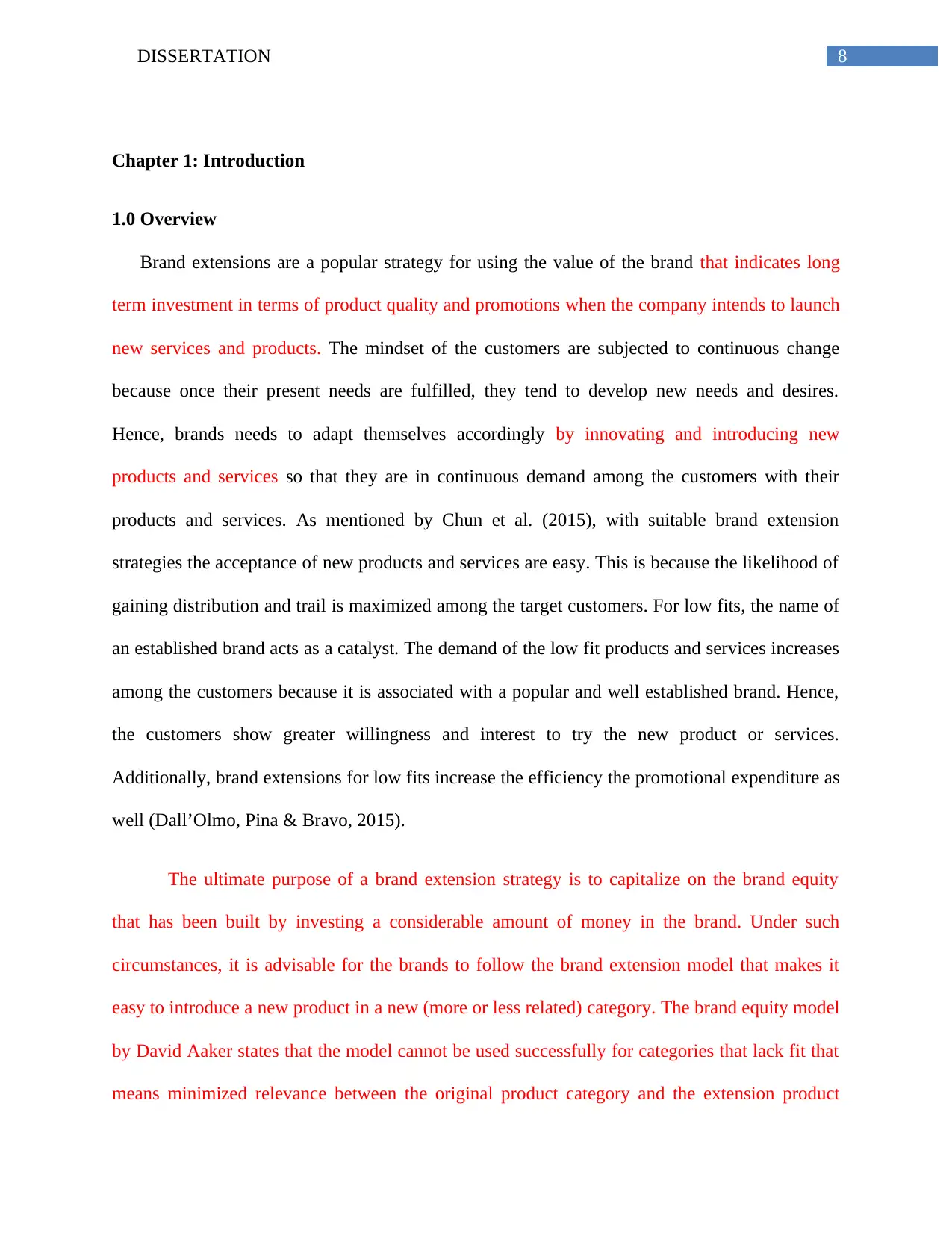
8DISSERTATION
Chapter 1: Introduction
1.0 Overview
Brand extensions are a popular strategy for using the value of the brand that indicates long
term investment in terms of product quality and promotions when the company intends to launch
new services and products. The mindset of the customers are subjected to continuous change
because once their present needs are fulfilled, they tend to develop new needs and desires.
Hence, brands needs to adapt themselves accordingly by innovating and introducing new
products and services so that they are in continuous demand among the customers with their
products and services. As mentioned by Chun et al. (2015), with suitable brand extension
strategies the acceptance of new products and services are easy. This is because the likelihood of
gaining distribution and trail is maximized among the target customers. For low fits, the name of
an established brand acts as a catalyst. The demand of the low fit products and services increases
among the customers because it is associated with a popular and well established brand. Hence,
the customers show greater willingness and interest to try the new product or services.
Additionally, brand extensions for low fits increase the efficiency the promotional expenditure as
well (Dall’Olmo, Pina & Bravo, 2015).
The ultimate purpose of a brand extension strategy is to capitalize on the brand equity
that has been built by investing a considerable amount of money in the brand. Under such
circumstances, it is advisable for the brands to follow the brand extension model that makes it
easy to introduce a new product in a new (more or less related) category. The brand equity model
by David Aaker states that the model cannot be used successfully for categories that lack fit that
means minimized relevance between the original product category and the extension product
Chapter 1: Introduction
1.0 Overview
Brand extensions are a popular strategy for using the value of the brand that indicates long
term investment in terms of product quality and promotions when the company intends to launch
new services and products. The mindset of the customers are subjected to continuous change
because once their present needs are fulfilled, they tend to develop new needs and desires.
Hence, brands needs to adapt themselves accordingly by innovating and introducing new
products and services so that they are in continuous demand among the customers with their
products and services. As mentioned by Chun et al. (2015), with suitable brand extension
strategies the acceptance of new products and services are easy. This is because the likelihood of
gaining distribution and trail is maximized among the target customers. For low fits, the name of
an established brand acts as a catalyst. The demand of the low fit products and services increases
among the customers because it is associated with a popular and well established brand. Hence,
the customers show greater willingness and interest to try the new product or services.
Additionally, brand extensions for low fits increase the efficiency the promotional expenditure as
well (Dall’Olmo, Pina & Bravo, 2015).
The ultimate purpose of a brand extension strategy is to capitalize on the brand equity
that has been built by investing a considerable amount of money in the brand. Under such
circumstances, it is advisable for the brands to follow the brand extension model that makes it
easy to introduce a new product in a new (more or less related) category. The brand equity model
by David Aaker states that the model cannot be used successfully for categories that lack fit that
means minimized relevance between the original product category and the extension product
⊘ This is a preview!⊘
Do you want full access?
Subscribe today to unlock all pages.

Trusted by 1+ million students worldwide
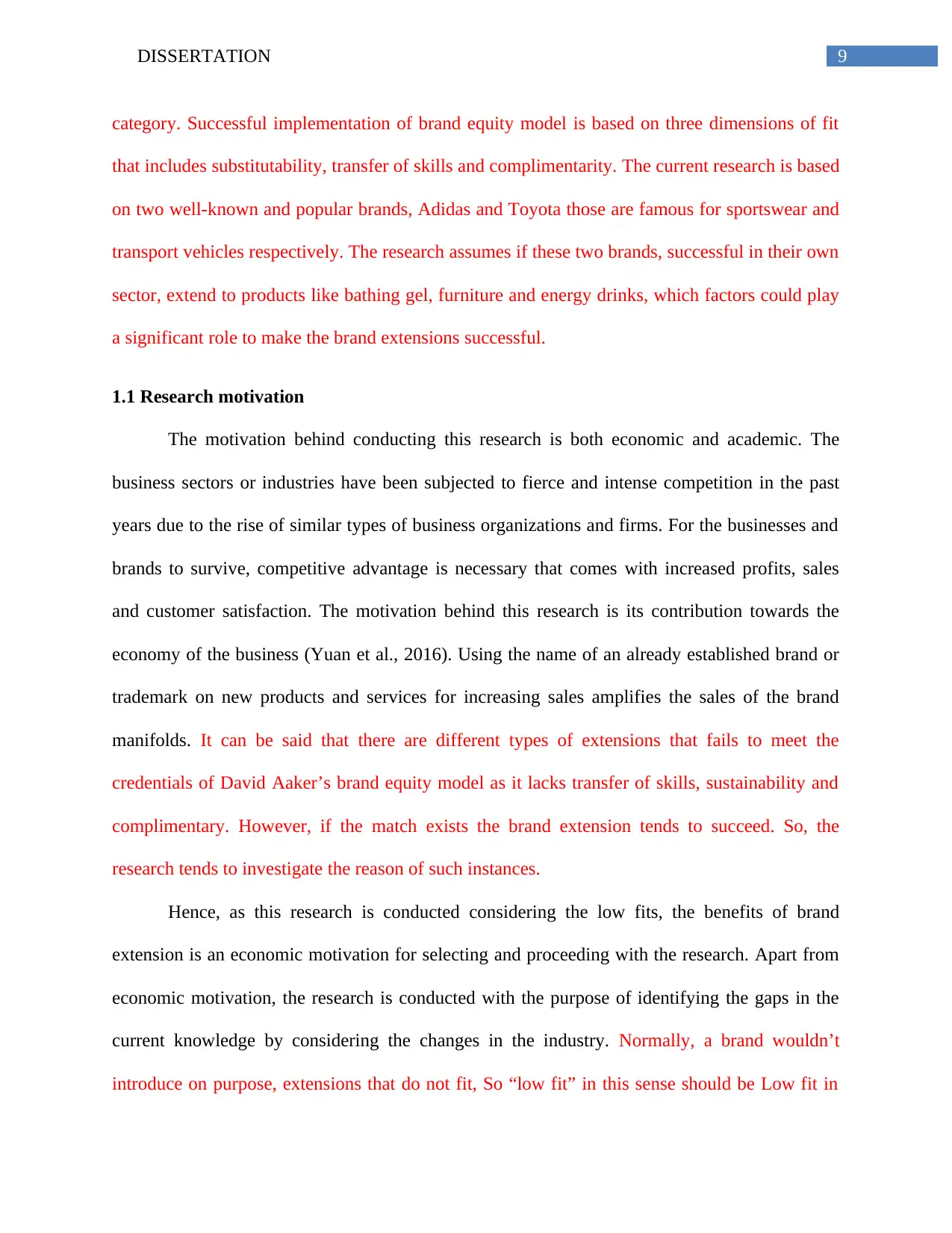
9DISSERTATION
category. Successful implementation of brand equity model is based on three dimensions of fit
that includes substitutability, transfer of skills and complimentarity. The current research is based
on two well-known and popular brands, Adidas and Toyota those are famous for sportswear and
transport vehicles respectively. The research assumes if these two brands, successful in their own
sector, extend to products like bathing gel, furniture and energy drinks, which factors could play
a significant role to make the brand extensions successful.
1.1 Research motivation
The motivation behind conducting this research is both economic and academic. The
business sectors or industries have been subjected to fierce and intense competition in the past
years due to the rise of similar types of business organizations and firms. For the businesses and
brands to survive, competitive advantage is necessary that comes with increased profits, sales
and customer satisfaction. The motivation behind this research is its contribution towards the
economy of the business (Yuan et al., 2016). Using the name of an already established brand or
trademark on new products and services for increasing sales amplifies the sales of the brand
manifolds. It can be said that there are different types of extensions that fails to meet the
credentials of David Aaker’s brand equity model as it lacks transfer of skills, sustainability and
complimentary. However, if the match exists the brand extension tends to succeed. So, the
research tends to investigate the reason of such instances.
Hence, as this research is conducted considering the low fits, the benefits of brand
extension is an economic motivation for selecting and proceeding with the research. Apart from
economic motivation, the research is conducted with the purpose of identifying the gaps in the
current knowledge by considering the changes in the industry. Normally, a brand wouldn’t
introduce on purpose, extensions that do not fit, So “low fit” in this sense should be Low fit in
category. Successful implementation of brand equity model is based on three dimensions of fit
that includes substitutability, transfer of skills and complimentarity. The current research is based
on two well-known and popular brands, Adidas and Toyota those are famous for sportswear and
transport vehicles respectively. The research assumes if these two brands, successful in their own
sector, extend to products like bathing gel, furniture and energy drinks, which factors could play
a significant role to make the brand extensions successful.
1.1 Research motivation
The motivation behind conducting this research is both economic and academic. The
business sectors or industries have been subjected to fierce and intense competition in the past
years due to the rise of similar types of business organizations and firms. For the businesses and
brands to survive, competitive advantage is necessary that comes with increased profits, sales
and customer satisfaction. The motivation behind this research is its contribution towards the
economy of the business (Yuan et al., 2016). Using the name of an already established brand or
trademark on new products and services for increasing sales amplifies the sales of the brand
manifolds. It can be said that there are different types of extensions that fails to meet the
credentials of David Aaker’s brand equity model as it lacks transfer of skills, sustainability and
complimentary. However, if the match exists the brand extension tends to succeed. So, the
research tends to investigate the reason of such instances.
Hence, as this research is conducted considering the low fits, the benefits of brand
extension is an economic motivation for selecting and proceeding with the research. Apart from
economic motivation, the research is conducted with the purpose of identifying the gaps in the
current knowledge by considering the changes in the industry. Normally, a brand wouldn’t
introduce on purpose, extensions that do not fit, So “low fit” in this sense should be Low fit in
Paraphrase This Document
Need a fresh take? Get an instant paraphrase of this document with our AI Paraphraser
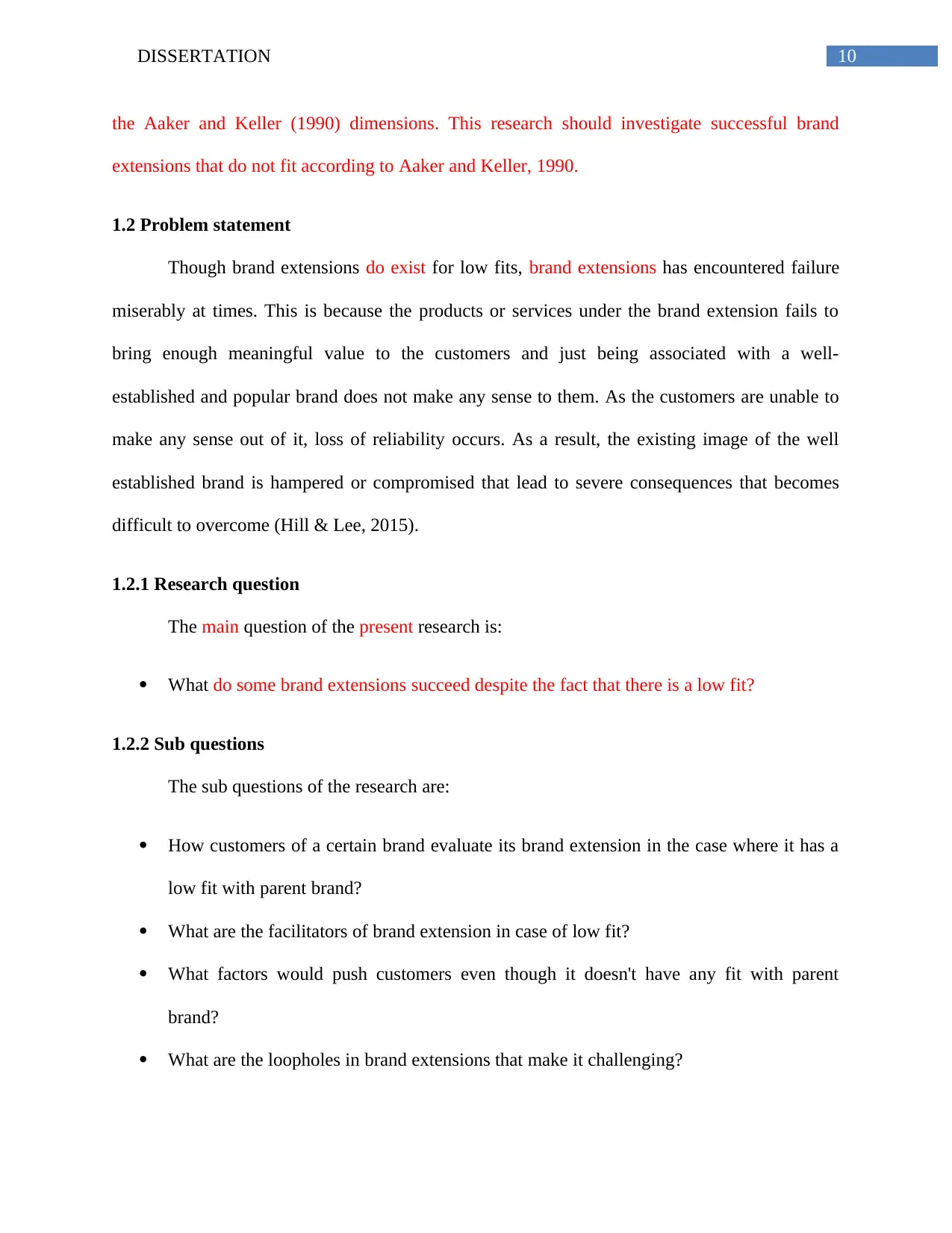
10DISSERTATION
the Aaker and Keller (1990) dimensions. This research should investigate successful brand
extensions that do not fit according to Aaker and Keller, 1990.
1.2 Problem statement
Though brand extensions do exist for low fits, brand extensions has encountered failure
miserably at times. This is because the products or services under the brand extension fails to
bring enough meaningful value to the customers and just being associated with a well-
established and popular brand does not make any sense to them. As the customers are unable to
make any sense out of it, loss of reliability occurs. As a result, the existing image of the well
established brand is hampered or compromised that lead to severe consequences that becomes
difficult to overcome (Hill & Lee, 2015).
1.2.1 Research question
The main question of the present research is:
What do some brand extensions succeed despite the fact that there is a low fit?
1.2.2 Sub questions
The sub questions of the research are:
How customers of a certain brand evaluate its brand extension in the case where it has a
low fit with parent brand?
What are the facilitators of brand extension in case of low fit?
What factors would push customers even though it doesn't have any fit with parent
brand?
What are the loopholes in brand extensions that make it challenging?
the Aaker and Keller (1990) dimensions. This research should investigate successful brand
extensions that do not fit according to Aaker and Keller, 1990.
1.2 Problem statement
Though brand extensions do exist for low fits, brand extensions has encountered failure
miserably at times. This is because the products or services under the brand extension fails to
bring enough meaningful value to the customers and just being associated with a well-
established and popular brand does not make any sense to them. As the customers are unable to
make any sense out of it, loss of reliability occurs. As a result, the existing image of the well
established brand is hampered or compromised that lead to severe consequences that becomes
difficult to overcome (Hill & Lee, 2015).
1.2.1 Research question
The main question of the present research is:
What do some brand extensions succeed despite the fact that there is a low fit?
1.2.2 Sub questions
The sub questions of the research are:
How customers of a certain brand evaluate its brand extension in the case where it has a
low fit with parent brand?
What are the facilitators of brand extension in case of low fit?
What factors would push customers even though it doesn't have any fit with parent
brand?
What are the loopholes in brand extensions that make it challenging?
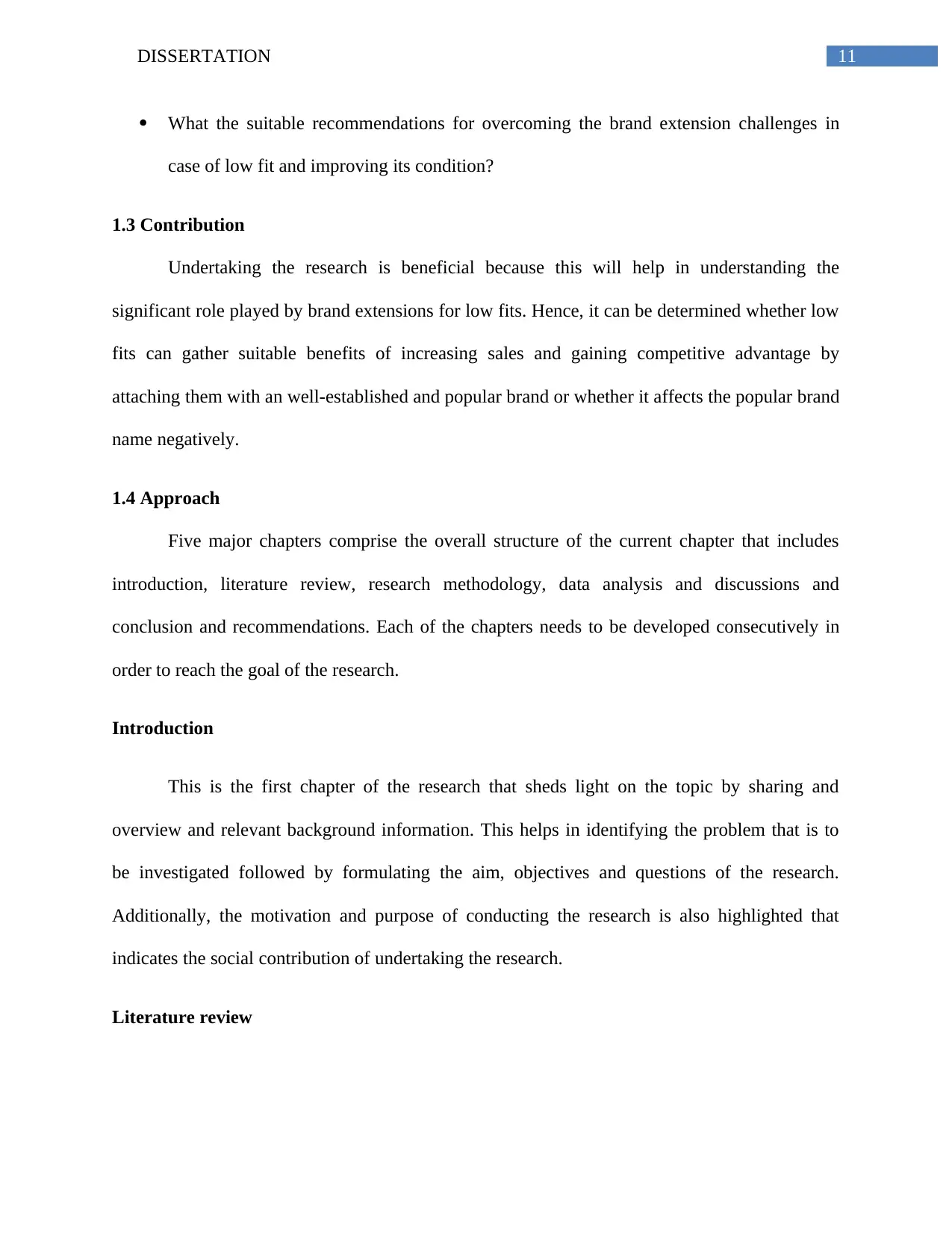
11DISSERTATION
What the suitable recommendations for overcoming the brand extension challenges in
case of low fit and improving its condition?
1.3 Contribution
Undertaking the research is beneficial because this will help in understanding the
significant role played by brand extensions for low fits. Hence, it can be determined whether low
fits can gather suitable benefits of increasing sales and gaining competitive advantage by
attaching them with an well-established and popular brand or whether it affects the popular brand
name negatively.
1.4 Approach
Five major chapters comprise the overall structure of the current chapter that includes
introduction, literature review, research methodology, data analysis and discussions and
conclusion and recommendations. Each of the chapters needs to be developed consecutively in
order to reach the goal of the research.
Introduction
This is the first chapter of the research that sheds light on the topic by sharing and
overview and relevant background information. This helps in identifying the problem that is to
be investigated followed by formulating the aim, objectives and questions of the research.
Additionally, the motivation and purpose of conducting the research is also highlighted that
indicates the social contribution of undertaking the research.
Literature review
What the suitable recommendations for overcoming the brand extension challenges in
case of low fit and improving its condition?
1.3 Contribution
Undertaking the research is beneficial because this will help in understanding the
significant role played by brand extensions for low fits. Hence, it can be determined whether low
fits can gather suitable benefits of increasing sales and gaining competitive advantage by
attaching them with an well-established and popular brand or whether it affects the popular brand
name negatively.
1.4 Approach
Five major chapters comprise the overall structure of the current chapter that includes
introduction, literature review, research methodology, data analysis and discussions and
conclusion and recommendations. Each of the chapters needs to be developed consecutively in
order to reach the goal of the research.
Introduction
This is the first chapter of the research that sheds light on the topic by sharing and
overview and relevant background information. This helps in identifying the problem that is to
be investigated followed by formulating the aim, objectives and questions of the research.
Additionally, the motivation and purpose of conducting the research is also highlighted that
indicates the social contribution of undertaking the research.
Literature review
⊘ This is a preview!⊘
Do you want full access?
Subscribe today to unlock all pages.

Trusted by 1+ million students worldwide
1 out of 86
Related Documents
Your All-in-One AI-Powered Toolkit for Academic Success.
+13062052269
info@desklib.com
Available 24*7 on WhatsApp / Email
![[object Object]](/_next/static/media/star-bottom.7253800d.svg)
Unlock your academic potential
Copyright © 2020–2025 A2Z Services. All Rights Reserved. Developed and managed by ZUCOL.





